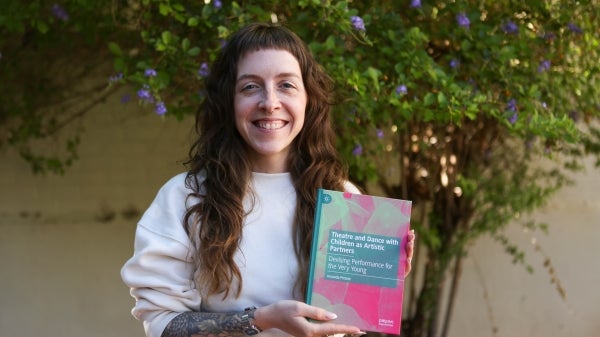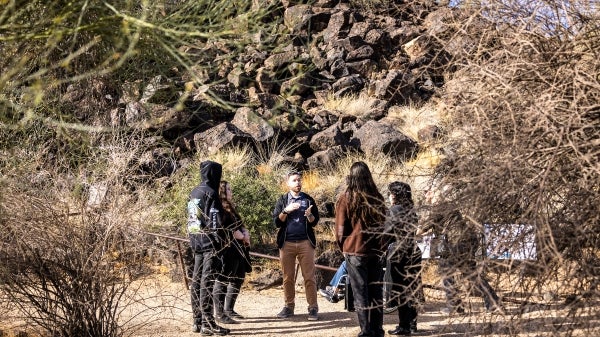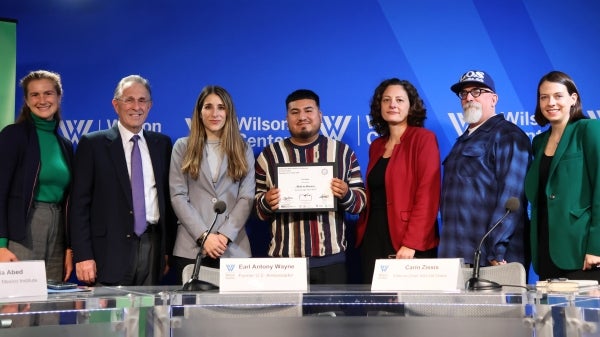The Poitier Film School hosts Emmy-winning ‘Shōgun’ costume designer Carlos Rosario in LA

From left: Moderator Spencer Williams; "Shōgun" costume designer Carlos Rosario, former curator of Japanese art at Los Angeles County Museum of Art Hollis Goodall; and Japanese American Cultural and Community Center (JACCC) master artist-in-residence Hirokazu Kosaka speak onstage at the JACCC in a panel discussion. Photo courtesy The Poitier Film School
The Emmy and Golden Globe award-winning blockbuster FX series “Shōgun” doesn’t just have audiences in its thrall, but the creators who brought it to life, as well.
“When the show came out, it just became incredibly overwhelming to see how it was received by the audience,” said Emmy Award-winning costume designer Carlos Rosario before a packed crowd at a public event hosted by The Sidney Poitier New American Film School, in partnership with ASU FIDM, at the Japanese American Cultural and Community Center (JACCC) in downtown Los Angeles on Wednesday, Feb. 5.
“It might never happen again,” Rosario said. “I decided to embrace this adventure as much as possible.”
Rosario, whose lush designs play an instrumental role in bringing 17th-century Japan to life in the sweeping historical drama, spoke in a moderated panel discussion following a screening of the series’ pilot episode, “Anjin.” The panel, moderated by Spencer Williams, program manager of events and student engagement with the ASU Herberger Institute for Design and the Arts and co-host of “The Art of Costume” podcast, also included Hollis Goodall, former curator of Japanese art at the Los Angeles County Museum of Art, and Hirokazu Kosaka, master artist-in-residence at the JACCC.
“We’re so thrilled that we’re partnered with the JACCC, and so thrilled that ASU FIDM are partners with us in this,” said Peter Murrieta, deputy director of The Poitier Film School and the Emmy Award-winning writer known for series like Netflix’s "Mr. Iglesias" and Disney’s "Wizards of Waverly Place." Murrieta, along with The Poitier Film School’s Founding Director Cheryl Boone Isaacs, introduced the evening, paying special thanks to FX Networks as well as James Casey Holland and Christian Cordella, “Shōgun” costume concept artists whose illustrations were on display in the lobby.
Rosario, who was born in France and is of Spanish descent, highlighted what a global, multinational effort “Shōgun” is and the exhaustive research process that went into bringing this historical era to life.
“I think it was all about color. The first time they sent me the script, what came to me right away is that I knew it was going to be a show about colors and fabric,” Rosario said. “The show was so big, and there were so many different characters, I thought the color palette was going to bring harmony to the visuals.”
To help the audience follow the characters better, Rosario assigned different color palettes to each group.
“I’ve been studying the costumes intensively over the past couple of weeks, and you really hit it. You hit every one,” Goodall said.
Goodall provided deeper insight into the use of materials, fabrics and colors in Japanese fashion during this period. Peacock feathers and chintz patterns, Goodall said, were introduced to Japanese fashion by way of India, while dramatic shades of red seen in the show would have been made with expensive dyes made from flowers and insects, like cochineal, imported by Spain.
“Kimono is the genius of pattern matching. The patterns don’t match each other, but when they’re put together by somebody with exquisite taste,” Hollis said, gesturing to Rosario, “they really complement each other.”
Kosaka, who is also an ordained Shingon Buddhist priest and a master of the art of Japanese archery, called attention to Rosario’s use of white in costuming. In Japanese culture, Kosaka said, white is the color of “transition” — appropriate in both marriage and seppukuA form of taking one's own life that was considered honorable among the feudal Japanese samurai class..
“Kimono comes from the word ‘ki,’ the center of your body,” Kosaka said. Ki is the Japanese word for spirit or energy, an animating force. “It’s very important that kimono and samurai warriors are very centered in the stomach. Seppuku came from that notion of the ki.” Wearing certain garb centers one spiritually, a concept Kosaka saw reflected in the show’s costuming.
When asked for his advice to Herberger’s film and fashion students in the audience, Rosario emphasized how crucial it is to build a strong educational foundation — and, just as importantly, how crucial it is to absorb as much as you can about the world and how to be a person in it.
“Being a costume designer is not about the clothing aspect, it’s the distance between the heart of the character and the outer envelope,” Rosario said. “The more you know in life about anything, about the human condition and the different layers of human beings ... the more you will be able to understand your characters.”
And it’s clear Rosario understands his characters. The night after this event, Rosario added another laurel to his crown: He was named the winner of the award for Excellence in Period Television at the 2025 Costume Designers Guild Awards.
More Arts, humanities and education

ASU professor explores theater, dance for young children in new book
Arizona State University Assistant Professor Amanda Pintore believes in the artistic capacity of very young children. She's hoping to spread that awareness to others with the recent publication of…

Petroglyph preserve celebrates 30th anniversary with ancient, modern tales
The Deer Valley Petroglyph Preserve provides a beautiful walk through a pristine desert where chuckwalla lizards are as plentiful as the cacti that comes in many shapes and sizes.It’s also a step…

Kaleidoscope short film contest inspires powerful binational filmmaking in its second year
“We come to this country not to steal anybody’s jobs but to take advantage of the opportunities that the rest ignore. We’ve been taking care of the American soil for many years. But our hands will…